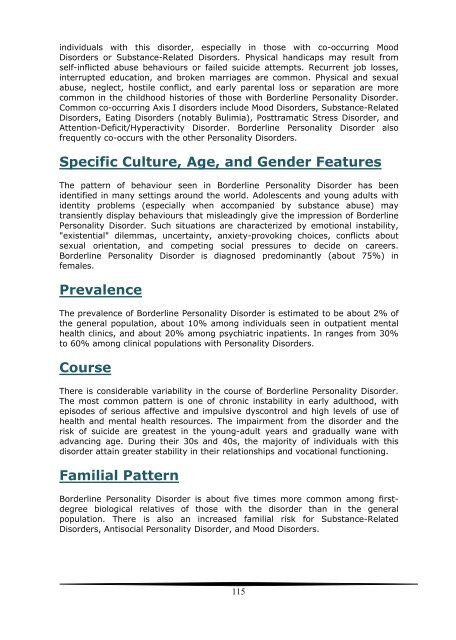personality disorders explained
Antisocial Personality Disorder, Codependence, Narcissism and Borderline
Antisocial Personality Disorder, Codependence, Narcissism and Borderline
Create successful ePaper yourself
Turn your PDF publications into a flip-book with our unique Google optimized e-Paper software.
individuals with this disorder, especially in those with co-occurring Mood<br />
Disorders or Substance-Related Disorders. Physical handicaps may result from<br />
self-inflicted abuse behaviours or failed suicide attempts. Recurrent job losses,<br />
interrupted education, and broken marriages are common. Physical and sexual<br />
abuse, neglect, hostile conflict, and early parental loss or separation are more<br />
common in the childhood histories of those with Borderline Personality Disorder.<br />
Common co-occurring Axis I <strong>disorders</strong> include Mood Disorders, Substance-Related<br />
Disorders, Eating Disorders (notably Bulimia), Posttramatic Stress Disorder, and<br />
Attention-Deficit/Hyperactivity Disorder. Borderline Personality Disorder also<br />
frequently co-occurs with the other Personality Disorders.<br />
Specific Culture, Age, and Gender Features<br />
The pattern of behaviour seen in Borderline Personality Disorder has been<br />
identified in many settings around the world. Adolescents and young adults with<br />
identity problems (especially when accompanied by substance abuse) may<br />
transiently display behaviours that misleadingly give the impression of Borderline<br />
Personality Disorder. Such situations are characterized by emotional instability,<br />
"existential" dilemmas, uncertainty, anxiety-provoking choices, conflicts about<br />
sexual orientation, and competing social pressures to decide on careers.<br />
Borderline Personality Disorder is diagnosed predominantly (about 75%) in<br />
females.<br />
Prevalence<br />
The prevalence of Borderline Personality Disorder is estimated to be about 2% of<br />
the general population, about 10% among individuals seen in outpatient mental<br />
health clinics, and about 20% among psychiatric inpatients. In ranges from 30%<br />
to 60% among clinical populations with Personality Disorders.<br />
Course<br />
There is considerable variability in the course of Borderline Personality Disorder.<br />
The most common pattern is one of chronic instability in early adulthood, with<br />
episodes of serious affective and impulsive dyscontrol and high levels of use of<br />
health and mental health resources. The impairment from the disorder and the<br />
risk of suicide are greatest in the young-adult years and gradually wane with<br />
advancing age. During their 30s and 40s, the majority of individuals with this<br />
disorder attain greater stability in their relationships and vocational functioning.<br />
Familial Pattern<br />
Borderline Personality Disorder is about five times more common among firstdegree<br />
biological relatives of those with the disorder than in the general<br />
population. There is also an increased familial risk for Substance-Related<br />
Disorders, Antisocial Personality Disorder, and Mood Disorders.<br />
115

















